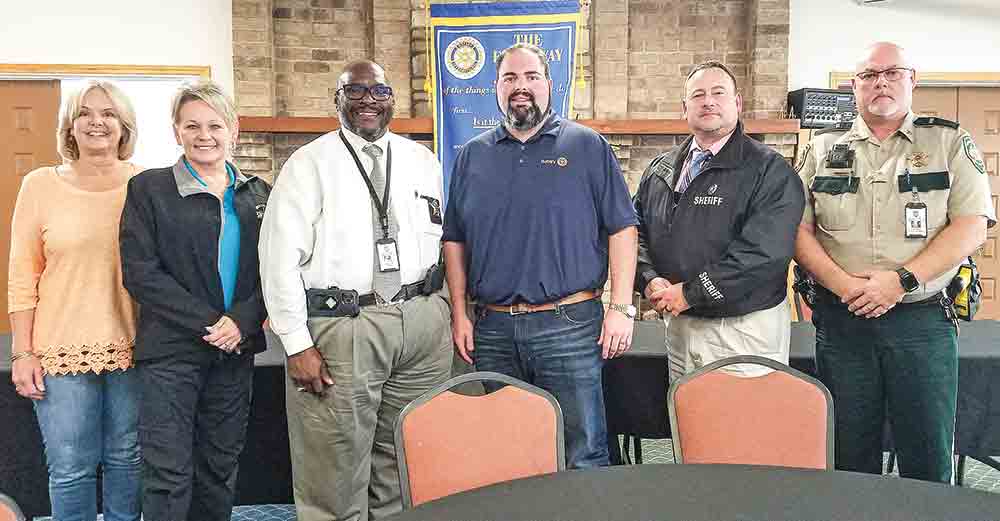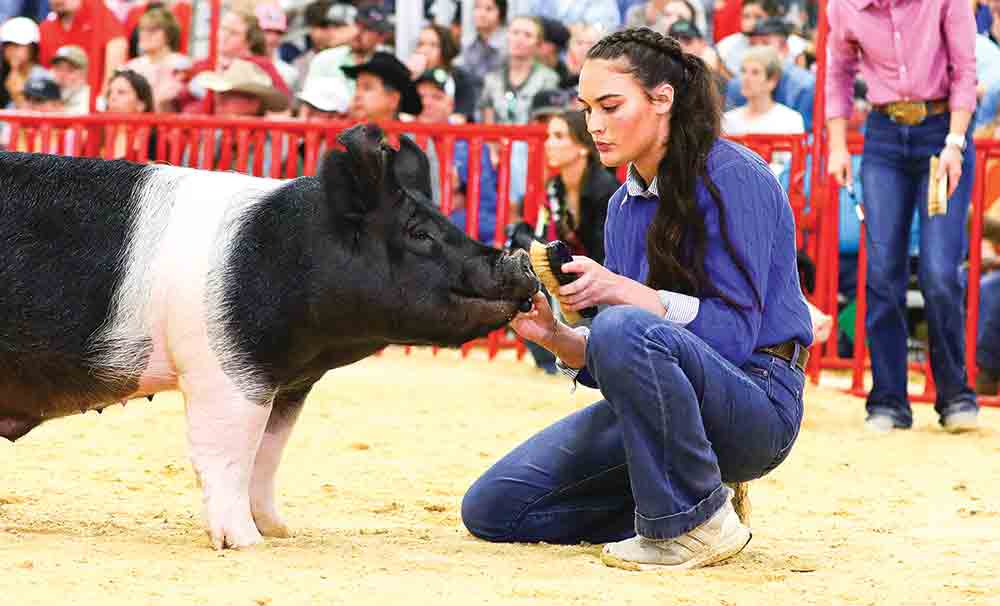 Write a comment
Write a comment
 By Emily Banks Wooten
By Emily Banks Wooten
This email address is being protected from spambots. You need JavaScript enabled to view it.
The annual report from the Polk County AgriLife Extension Office was presented to the Polk County Commissioners Court Feb. 28 with numerous people reporting on the department’s various activities.
Alissa Kimbro, who is in her 13th year with the county, her 15th year with extension and her 20th year in education, told about the 4-H day camp and the summer camps that were held.
“We’re teaching kids how to start fires and put them out. We used ribeyes this year. The kids really enjoyed it. Then we took it back in time and taught the kids how to make jelly, so they are learning the canning process,” Kimbro said, adding that they also worked on some leadership activities.
She introduced Eddie Turk, one of the local 4-H students.
“I’ve been active in 4-H shooting sports for about five years. This is my second time as the Livingston 4-H president,” Turk said.
“My favorite thing about shooting sports is it teaches you how to handle and use a firearm properly which everybody needs to know. And my favorite thing about 4-H, as a whole, is it has provided me opportunities to improve my leadership and my communication skills. I’ve had several opportunities to go to the 4-H junior leadership labs and that helped me with learning how to work with people and being a leader and I would recommend 4-H activities to anybody,” Turk said.
Transitioning from 4-H to ag, Polk County AgriLife Extension Agent Matthew March reported on some of the ag and natural resource education that was conducted.
“I invited John and Tina Crichfield, two producers I work with here in the county. They have a cattle operation/recreational property out on East Clamon Road. Tina also works with me a lot with Master Naturalists,” March said.
“Texas Master Naturalists, we couldn’t have the program without the ag extension office and without Matt. We are especially grateful for the education and workshops and seminars that he provides both to us as Texas Master Naturalists and the opportunities he provides us to work with the community in helping to educate them and be better stewards of our environment here locally. I’m this year’s training director and we have the largest training class we’ve ever had,” Tina said.
“We are very grateful that we have an extension agent that likes to come out and take a look at our land,” John said. “We’ve had problems with our pastures and he has given us a plan to get that under control. We’ve had pond issues and the pond seminar that he did for the continuing ed out at our place gave us a whole lot of new insight as to how to get our algae fish-killing pond under control. Him bringing out wildlife biologists, hydrologists and trappers gave us a much better idea of how to bring some of our property problems under control.”
Gary Ashmore, general manager of the Lower Trinity Groundwater Conservation District spoke next.
“I serve on the Farm Bureau as a volunteer and on the board. Matt came to us with the idea of having an informal, educational growers breakfast. It’s called the Polk County Growers Breakfast. It’s bi-monthly, the last Friday of the month. We invite people who actually make a living in the county growing things and selling things, as well as amateurs such as myself that want to pretend to be farmers. It’s a great breakfast that’s been growing over two years. It was recognized by the State Farm Bureau. Of the entire state, it was chosen as the most innovative and educational new program that had been started in the state. Matt was called down to Corpus Christi and given an award at the state annual membership and we were very proud of that,” Ashmore said.
“The growers breakfast is a fantastic thing. It’s word of mouth. We have over 50 people. Our last meeting two weeks ago was 40 people. Every other month Matt brings in an expert from A&M, tells us how to grow things organically, which fruit trees to grow, how to grow bees. Matt does a fantastic job. I think he’s undervalued. He does good for us. He’s a valuable asset,” Ashmore said.
“Gary underestimates himself too. I wouldn’t be able to do the growers breakfast without him. He gets all the IT together and sends out the emails and everything,” March said. “I just want to hit the highlights. I have three main programs that I do – beef and forage education, produce education and wildlife and habitat improvement education.
“We all know cattle’s a big deal, the number one livestock inventory in the county. This year with the drought and rising input costs and fertilizer costing $1,000 a ton we had to look real hard on trying to get education to improve efficiency of operations. We did a beef and forage workshop in the county where we went out to W.R. Baker’s ranch and worked on fertilizer and weed ID out there. We did our annual pesticide certification and we did our Cow County Congress in Madisonville,” March said.
“As for produce education, there are two main things. One is the bi-monthly produce growers breakfast meeting over at the Farm Bureau. The highlight of that this last year is we did a county farm tour. We went out to Sweet Wings Farms, Mr. Snook’s farm and C&M Blueberries and we had about 20 people or so that got to go tour around the county. They got to see techniques that they could take into their operations,” March said.
“The other thing that Deborah’s going to talk about more is we have a senior citizen community garden at the extension office where we have volunteers manage it and we take produce over to the senior center and we do a monthly lunch and learn with them and teach them how to incorporate healthy vegetables into their diet. It’s pretty neat. Fourteen of the seniors that we surveyed said they added at least one new fruit, vegetable or seed to their diet. That’s pretty neat because a lot of them have limited funds and don’t have access to good vegetables. Last year we raised 676 pounds of produce from the garden and that equated to around 1,800 individual pieces of vegetables,” March said.
“As for wildlife and habitat improvement education, we know that timber’s a big deal here in the county. We do field tours which Tina and John mentioned, where we did the pond management out at their property. We took landowners out there to look at the ponds in person. I’m also part of the forest pest seminar up in Lufkin which caters to commercial loggers and foresters and we have quite a few from here in Polk County that go to that. Last year the economic impact for that was estimated at around $274,000 to our local loggers,” March said.
“We have gotten a lot of positive feedback on the community garden, especially from the senior citizens that have been getting vegetables to take home and also receiving education, so that has been nice,” County Judge Sydney Murphy said.
The next to speak was Deborah Alvarado, the health agent for Polk County and Trinity County.
“Matt and I have been doing lunch and learns with the senior citizens. We have been presenting them with recipes. We use the vegetables from the garden and then I do a cooking demonstration with them and show them how to use the vegetables that they can grow and also talk to them about the health and nutrition benefits of each of the vegetables. I always try to bring things in. There are certain vegetables that people just don’t like and are not going to try. Last week we did turnips and the month before that we featured kohlrabi. These are things that a lot of people are just not going to try so I’m always trying to come up with new recipes and ways to make them taste better and more appealing. The seniors really seem to like it. When we did our evaluation with them last year everything was 100% – they were learning, they were enjoying eating more vegetables and that they were even cooking more vegetables” Alvarado said.
“I’ve started working with Goodrich ISD on a program called Learn Grow Eat Go. It’s for third, fourth and fifth-graders and there are about 54 students. I’m teaching them how to garden, nutrition, healthy eating, physical activity. The intent is to start them young to get them into healthy habits and to teach them about gardening so that it will be more of a lifelong activity for them,” Alvarado said.
“I’m also doing a program called Walk Across Texas. It’s a program that encourages physical activity. The whole idea is that over an eight-week period, they form teams and walk 832 miles or more. That is the distance from Orange to El Paso so they are, figuratively, walking across Texas. There are about 305 people participating and that includes students, teachers, staff and parents. The goal is to teach them to be more conscious about physical activity and moving more. I hope this is just the beginning and that we’ll be able to expand to other schools in Polk County,” Alvarado said.
Kimbro wrapped things up, thanking the commissioners court for its support and commenting that the extension programs could not do what they do without the court.
“We did not mention that Matt did win a superior service award through Texas A&M AgriLife Extension. It’s one of the highest awards in the A&M system. He won for the efforts that he put forth with the Onalaska tornado, getting the team out here and doing all of that. We are very, very lucky to have him,” she said.
 Polk County Sheriff Byron Lyons and others from his department presented a program to the Rotary Club of Livingston Thursday. (l-r) Rotarian Trina Fowlkes, Special Victims Liaison Christie Allen, Lyons, Rotary President Andrew Boyce, Cptn. Dave Sottosanti and Lt. Glenn Edwards. Photo by Emily Banks WootenBy Emily Banks Wooten
Polk County Sheriff Byron Lyons and others from his department presented a program to the Rotary Club of Livingston Thursday. (l-r) Rotarian Trina Fowlkes, Special Victims Liaison Christie Allen, Lyons, Rotary President Andrew Boyce, Cptn. Dave Sottosanti and Lt. Glenn Edwards. Photo by Emily Banks WootenBy Emily Banks Wooten

 By Emily Banks Wooten
By Emily Banks Wooten


